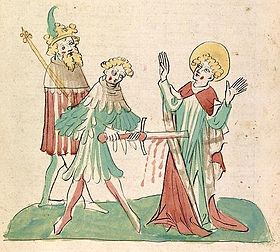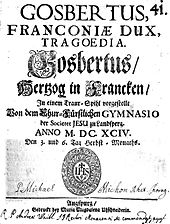Gosbert

Gosbert , also Gozbert according to the older spelling and Latinized Gosbertus / Gozbertus , was an East Franconian duke in the Franconian Empire , ruled in Würzburg and became one of the first Christians in the region.
Family background
The East Franconian Duke Gosbert (Gozbertus), son of the elder Hedan I (Hetanus), ruled in Würzburg . His son, in turn, was Hedan II. The family is referred to as Hedenen or Hetaniden.
Gosbert was married to his sister-in-law Gailana . According to legend, she had the Irish bishop Kilian and his companions who were missionary with him murdered around 689 (according to tradition on July 8, 689). Gosbert, originally a pious pagan, had himself baptized Christian by Kilian (against Gailana's will) (Gailana was also baptized - contrary to the legend of Kilian). The reason for the murder was that Kilian had tried to enforce the church prohibition of sister-in-law marriage.
Live and act

Gosbert is mainly reported in the life of Saint Kilian , called Passio Kiliani , from the 9th century. The historian Wilhelm Störmer considers the information given here on the genealogy of the early Franconian dukes to be entirely credible.
It says there: Like all his people, Gosbert still lived in paganism and worshiped the goddess Diana by name . When he heard about the missionary work and the speeches of St. Kilian, he had him come to him and talked to him. After a short time he convinced him to join Christianity and baptized him together with the people under him. But when he now forbade the duke, who according to traditional custom had the wife of his deceased brother as his wife, contrary to the gospel and the duke, albeit with a heavy heart, showed himself to leave Gailana out of love for God , her hatred flared up the Christian preachers. When Gosbert was absent on the campaign, Gailana used the opportunity in 688 and had the Franconian apostles secretly beheaded by a hired murderer at night and buried in their clothes in a hurry, along with the episcopal cross , the gospel book and other church equipment.
When Gosbert returned from the war and asked about Kilian, Gailana replied that she did not know anything about his whereabouts, but the murderer gave himself away because, running back and forth like mad, he confessed his guilt and ended up with the exclamation "Kilian, the Holy One of God, is burning me with the fiercest fire!" is mangled itself. Gailana also died insane.
Gosbert preserved the Christian faith to the end, but was killed by his own guard under the influence of the pagan Saxons. His son Hedan was driven out of the country by a popular uprising, as was the entire ducal family.
In contrast to the Vita, the martyrology of St. Hrabanus Maurus names Duke Gosbert as the commissioner of the murder of Kilian.
Posthumous appreciation

In the parish church of St. Maria Magdalena (Münnerstadt) there are 4 panel paintings by Veit Stoss , for the legend of Kilians, made around 1505, on which Duke Gosbert is also represented.
As early as the 17th century, the Jesuit theater took on the subject and the order published a tragedy in three acts about it, which was performed in different places. In the early 19th century, the romantic poet Friedrich de la Motte Fouqué dedicated a tragedy to the Franconian Duke Gosbert, and in 1926 also the Franconian local historian Peter Schneider .
The Gosbertsteige in the Würzburg district of Zellerau is named after Duke Gosbert .
literature
- Franz Emmerich: Saint Kilian. Regional bishop and martyr. Würzburg 1896 (digitized)
- Wilhelm Störmer : On the origin and sphere of activity of the Merovingian “Main Franconian” dukes. In: Karl Rudolf Schnith (ed.): Festschrift for Eduard Hlawitschka on his 65th birthday (= Munich historical studies. Department of Medieval History 5), 1993, p. 11 ff. (PDF; 528 kB)
Web links
Individual evidence
- ↑ Reinhard Düchting : The Latin literature. In: Ulrich Wagner (Hrsg.): History of the city of Würzburg. 4 volumes, Volume I-III / 2 (I: From the beginnings to the outbreak of the Peasant War. 2001, ISBN 3-8062-1465-4 ; II: From the Peasant War 1525 to the transition to the Kingdom of Bavaria 1814. 2004, ISBN 3 -8062-1477-8 ; III / 1–2: From the transition to Bavaria to the 21st century. 2007, ISBN 978-3-8062-1478-9 ), Theiss, Stuttgart 2001–2007, Volume 1, 2001, p 450–458, here: p. 450 f.
- ^ Alfred Wendehorst : Bishopric and royal city - From the Carolingian era to the Worms Concordat. In: Ulrich Wagner (Hrsg.): History of the city of Würzburg. 2001–2007, Volume 1, 2001, pp. 62–73, here: p. 62.
- ↑ Website for the Veit Stoss pictures in Münnerstadt ( Memento of the original from March 7, 2014 in the Internet Archive ) Info: The archive link has been inserted automatically and has not yet been checked. Please check the original and archive link according to the instructions and then remove this notice.
- ^ Document of a performance in Landsberg am Lech, 1694, see Gosbertus, Franconiae dux. Tragoedia. Utzschneider, Augspurg 1694
- ↑ Document of a performance of Pruntrut in Switzerland, 1726, see Gosbertus. Tragoedia. Cuchot, Bruntrut 1726
- ^ Full text of the tragedy by Friedrich de la Motte Fouqué, 1817, see Friedrich Baron de la Motte Fouqué: Liebesrache. A tragedy in three acts. Fleischer, Leipzig 1817
- ↑ Find hint in Google Books
source
- The article is based on the article Gosbert from the free encyclopedia WürzburgWiki .
| personal data | |
|---|---|
| SURNAME | Gosbert |
| BRIEF DESCRIPTION | East Franconian Duke in the Franconian Empire, ruled in Würzburg and became one of the first Christians in the region |
| DATE OF BIRTH | 7th century |
| DATE OF DEATH | after 688 |